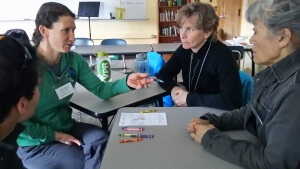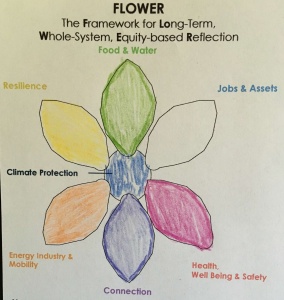FLOWER - A Simple Tool for Groups to Develop Climate Solutions with Multiple Benefits
By
Shanna Edberg
April 19, 2016
Projects that protect the climate can also boost well-being, equity, or resilience. But for groups of stakeholders with limited time and many complex goals and constraints it can be challenging to design for these benefits. We’ve created the FLOWER framework to make that process easier.
Here are some ways that FLOWER is being by groups around the world to design for climate co-benefits:
Bringing Co-Benefits and Equity into Environmental Education
Coleen O’Connell, an instructor with Lesley University’s Ecological Teaching and Learning Program, has been using the FLOWER diagram at environmental workshops across New England. T he teachers at these workshops love having a framework with which to discuss multiple benefits and equity. They are also enthusiastic about the way that FLOWER can broaden people’s sense of what acting on climate looks like, and that it gives opportunities to engage others even if climate change isn’t their primary focus. She is reaching 75 educators with FLOWER, many of whom will use it in turn in their own classrooms.
he teachers at these workshops love having a framework with which to discuss multiple benefits and equity. They are also enthusiastic about the way that FLOWER can broaden people’s sense of what acting on climate looks like, and that it gives opportunities to engage others even if climate change isn’t their primary focus. She is reaching 75 educators with FLOWER, many of whom will use it in turn in their own classrooms.
Helping Bhutanese Villagers Design Climate Adaptation Strategies
 Nirmala Nair with the School of Practical Sustainability is working as a climate change consultant for Bhutan’s National Adaptation Program for Action (NAPA II). Her work is focused on bringing an integrative perspective to preparing Bhutan for the consequences of climate change. She uses FLOWER in her work with Bhutanese villagers and smallholder farmers, assisting them to change farming methods and use erosion control, local water harvesting, and other climate-smart practices.
Nirmala Nair with the School of Practical Sustainability is working as a climate change consultant for Bhutan’s National Adaptation Program for Action (NAPA II). Her work is focused on bringing an integrative perspective to preparing Bhutan for the consequences of climate change. She uses FLOWER in her work with Bhutanese villagers and smallholder farmers, assisting them to change farming methods and use erosion control, local water harvesting, and other climate-smart practices.
Investing in Equity with Green Infrastructure in Atlanta

A group of community leaders in Atlanta, led by Climate Interactive and the Partnership for Southern Equity, used FLOWER at a workshop to compare potential green infrastructure investments and projects in terms of their co-benefits and what they wanted for their community.
Get Started with FLOWER
Interested in creating your own FLOWER diagram? Learn more and access the tool.

 he teachers at these workshops love having a framework with which to discuss multiple benefits and equity. They are also enthusiastic about the way that FLOWER can broaden people’s sense of what acting on climate looks like, and that it gives opportunities to engage others even if climate change isn’t their primary focus. She is reaching 75 educators with FLOWER, many of whom will use it in turn in their own classrooms.
he teachers at these workshops love having a framework with which to discuss multiple benefits and equity. They are also enthusiastic about the way that FLOWER can broaden people’s sense of what acting on climate looks like, and that it gives opportunities to engage others even if climate change isn’t their primary focus. She is reaching 75 educators with FLOWER, many of whom will use it in turn in their own classrooms. Nirmala Nair with the
Nirmala Nair with the 